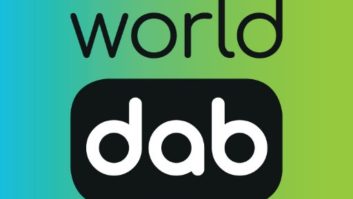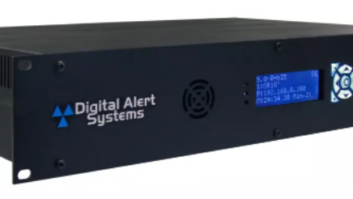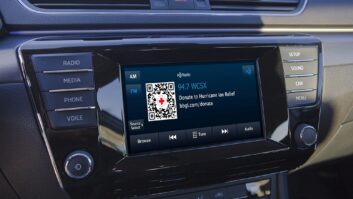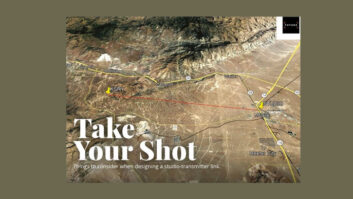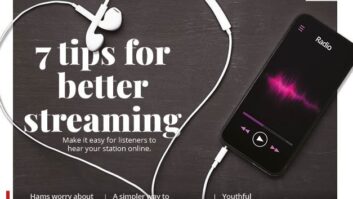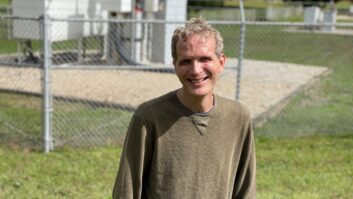Nick Piggott of RadioDNS shows the FM-IP seamless switch during the EBU Digital Radio Conference. BRUSSELS — This year’s EBU Digital Radio Conference, held Oct. 10–11 here in Brussels, played host to more than 50 senior managers from public service radio broadcasters.
Radio is now more than 110 years old, while digital radio is only 18, and like every debutante, digital radio is trying to make itself look more attractive. DAB has not had the easiest childhood, and now, during its adolescence, EBU members — as well as many other radio enthusiasts — are striving to find the best way to ensure that this medium reaches its potential.
Important considerations
Attendees presented and discussed various issues at the Brussels’ gathering. One returning question was that of the “chicken or egg” dilemma of what comes first: DAB receivers or DAB programs?
“We are the chicken, we must move first,” said Mathias Coinchon, EBU senior project manager. “Broadcasters have to agree on a single strategy, and then move forward together, in an attempt to gain the confidence of receiver manufacturers.”
The event focused on three listening scenarios: in-house, in-car and mobile. While in-house receivers are no longer a concern, with a wide choice of devices (at any price level) now available, in-car listening on the other hand is crucial for the success of digital radio. Specific car receivers, multi-tuners capable of seamlessly switching program content from FM to DAB (and vice-versa), are on their way.
Frank Nowack, function owner multimedia at Ford, reported that almost every car manufacturer will offer a DAB/DAB+ tuner as standard or an option on almost every listed car model by the middle of 2013. He also named 13 manufacturers capable of offering after-market solutions for cars already in use.
“We must focus on the added value of digital radio rather than only on audio quality,” he said, noting that it was also important to avoid any potential driver distraction, even when broadcast and Internet technologies are converging in the dashboard. Suitable chipsets for in-car reception are ready to enter the mass production phase.

Mathias Coinchon speaks at the annual EBU Digital Radio Conference. Ron Schiffelers, director of program management – business line car entertainment for NXP, highlighted the importance for the receiver to be able to switch a radio program from FM to DAB, and in doing so, to guarantee the compensation of any possible time delay and loudness discrepancy between analog and digital. He also explained that specific audio processing is required in order to avoid any “beep” or “scratch” sound that could distract the driver.
Magnetizing mobile
But the ultimate and hardest challenge is regarding mobile, battery-powered devices. Most mobile phones already include an FM receiver, and adding a DAB tuner is, technically speaking, not an issue.
“We have to find an effective way to drive smartphone manufacturers to include DAB chipsets inside their terminals,” Coinchon said, “and they won’t do so until their top customers — telco operators — ask them to.” Thus the next step for broadcasters is to foster a viable scenario where the telcos can also earn money (or, at least, payload) from digital radio.
“The Future Is Hybrid” was another key message during this year’s conference. “We must change radio into something that looks like an app,” said Nick Piggott, head of creative technology at Global Radio and chair of RadioDNS.
RadioDNS has an open-set of features, which enables radio to offer a multifaceted, exciting experience. “We have to take the best from broadcasting and the best from IP,” he said, “and integrate these features to obtain a powerful medium capable of engaging listeners.” He specifically outlined the possibility of FM/IP switching, “bookmarking” a song, or downloading a podcast to one’s home PC from a mobile.
“We must achieve a single radio app that is capable of tuning everything. This is the only way to have it factory-installed on every terminal, which is our real goal,” said Coinchon. “There needs to be a single app that allows a powerful and exciting new way for people to enjoy the radio.” It is possible to download, free of charge, turnkey packages to implement a RadioDNS platform and Visual Radio from the EBU Technical website (www.ebulabs.org).
Digital radio must be tasty: easy, interactive, cute. EBU managers have great expectations for the future of digital radio.
The general consensus from this meeting is that the various EBU members should implement at least one hybrid and interactive service as soon as possible, to prove the capabilities of digital hybrid radio to the mobile operators.
This would allow the latter to visualize and design a new business model, based on digital radio, that could foster the use of their wireless data services, eventually bringing them more revenue.
Davide Moro reports on the industry for Radio World from Bergamo, Italy.





